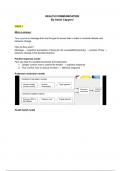HEALTH COMMUNICATION
By Asiah Capponi
WEEK 1
Micro Lectures:
Fear-appeal=a message that has the goal to arouse fear in order to motivate attitude and
behavior change
How do they work?
Message → cognition (perception of being at risk, susceptibility/severity) → emotion of fear →
behavior change in the decided direction
Parallel response model
Fear can lead to 2 parallel processes and responses:
1. Danger control: how to control the threat? → cognitive response
2. Fear control: how to reduce my fear? → affective response
Protection motivation model
Health belief model
,Shortcomings of all of these models:
- Only explain a part of how fear appeal work
- Unclear when or what fear appeals don’t work
EXTENDED PARALLEL PROCESS MODEL (Witte)
Appraisal = a perception, a judgment
Susceptibility: to what extent am I at risk?
Severity: how severe are the consequences?
,Self-efficacy: do I feel like I am capable of doing this specific thing?
Response efficacy: whether they believe that adopting the behavior will avoid the threat?
Readings:
Witte, K., & Allen, M. (2000). A meta-analysis of fear appeals: Implications for effective
public health campaigns. Health Education & Behavior, 27(5), 591-615 [ONLY READ
PAGES 591-595]
Tannenbaum, M. B., Hepler, J., Zimmerman, R., Saul, L., Jacobs, S., Wilson, K., &
Albarracin, D. (2015). Appealing to fear: a meta-analysis of fear appeal effectiveness
and theories. Psychological Bulletin, 141, 1178-1204.
Kok, G. J. (2016). Social psychology applied: Politics, theories, and the future.
Valedictorian lecture, Maastricht: Maastricht University. See
https://cris.maastrichtuniversity.nl/ws/portalfiles/portal/5719713/Oratie_Kok_Gerjo.pdf
Links to an external site. [ONLY READ PAGES 6-12]
Brown, S. L., & West, C. (2014). Sequencing the threat and recommendation
components of persuasive messages differentially improves the effectiveness of
high‐and low‐distressing imagery in an anti‐alcohol message in students. British
Journal of Health Psychology, 20(2), 324-340.
Reading Questions
Witte, K., & Allen, M. (2000). A meta-analysis of fear appeals: Implications for effective
public health campaigns. Health Education & Behavior, 27(5), 591-615. [ONLY READ
PAGES 591-595]
1. Describe the extended parallel process model (EPPM) of Witte.
Message a person perceives the threat à how susceptible am I to this threat? How efficient can
my response to the threat be? à OPT 1. Threat perceived as irrelevant à no action is taken;
OPT. 2 threat perceived as relevant à motivation to process the threat à FEAR à action to
reduce the fear: OPT 1: control the danger of the threat à high perceived self-efficacy and
response efficacy à think how to remove the threat; OPT. 2: control the fear à low self-efficacy
and response efficacy à focus on how to eliminate the fear (denial, avoidance)
, Tannenbaum, M. B., Hepler, J., Zimmerman, R., Saul, L., Jacobs, S., Wilson, K., &
Albarracin, D. (2015). Appealing to fear: a meta-analysis of fear appeal effectiveness and
theories. Psychological Bulletin, 141, 1178-1204.
1. Mention and explain the two forms of the efficacy statement hypothesis.
Strong hypothesis: fear appeals without efficacy statements will produce negative effects (will
backfire) [if I’m not telling you that you can do this or that this action will be useful, you will do
the opposite of what I want you to]
Weak hypothesis: fear appeals without efficacy statements will produce weaker effects [if I’m
not telling you that you can do this or that this action will be useful, it is harder to influence your
behavior]
*efficacy statement= a message that assures the recipient that they are capable of performing
the fear appeal’s recommended actions and/or performing the recommended actions will result
in desirable consequences.
2. This question aims to make you understand more about the specific moderators of the
relation between fear appeals (low vs high) and persuasive dependent variables and
challenges you to think critically.
i. Mention the hypotheses for the following moderators that may impact the
effectiveness of a fear appeal:
a) the message element of susceptibility; messages with high depicted severity
positively influenced attitudes, intentions, and behaviors, whereas messages with
high depicted susceptibility positively influenced intentions and behaviors but not
attitudes
b) the behavior element of one time versus repeated behavior; persuasive messages
should be more successful when they recommend one-time behaviors (e.g., getting
vaccinated) compared with behaviors that must be repeated over an extended period
of time (e.g., exercising)
c) the audience element of culture. fear appeals should be particularly effective for
female (vs. male) and collectivist (vs. individualist) audiences
*collectivist vs. individualistic culture
ii. Per element, check the method section to see how these elements are coded and
comment on this.
Depicted susceptibility and severity





